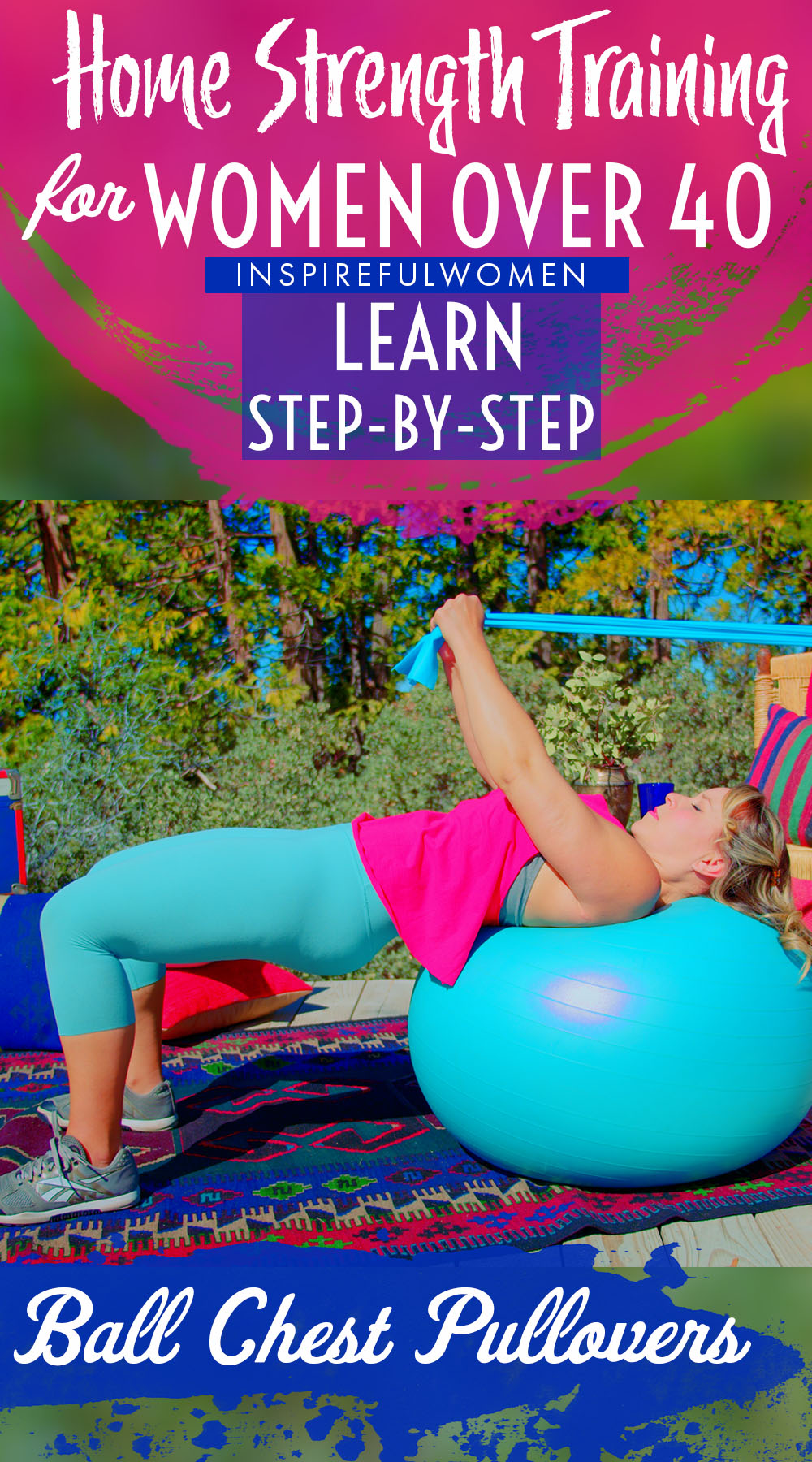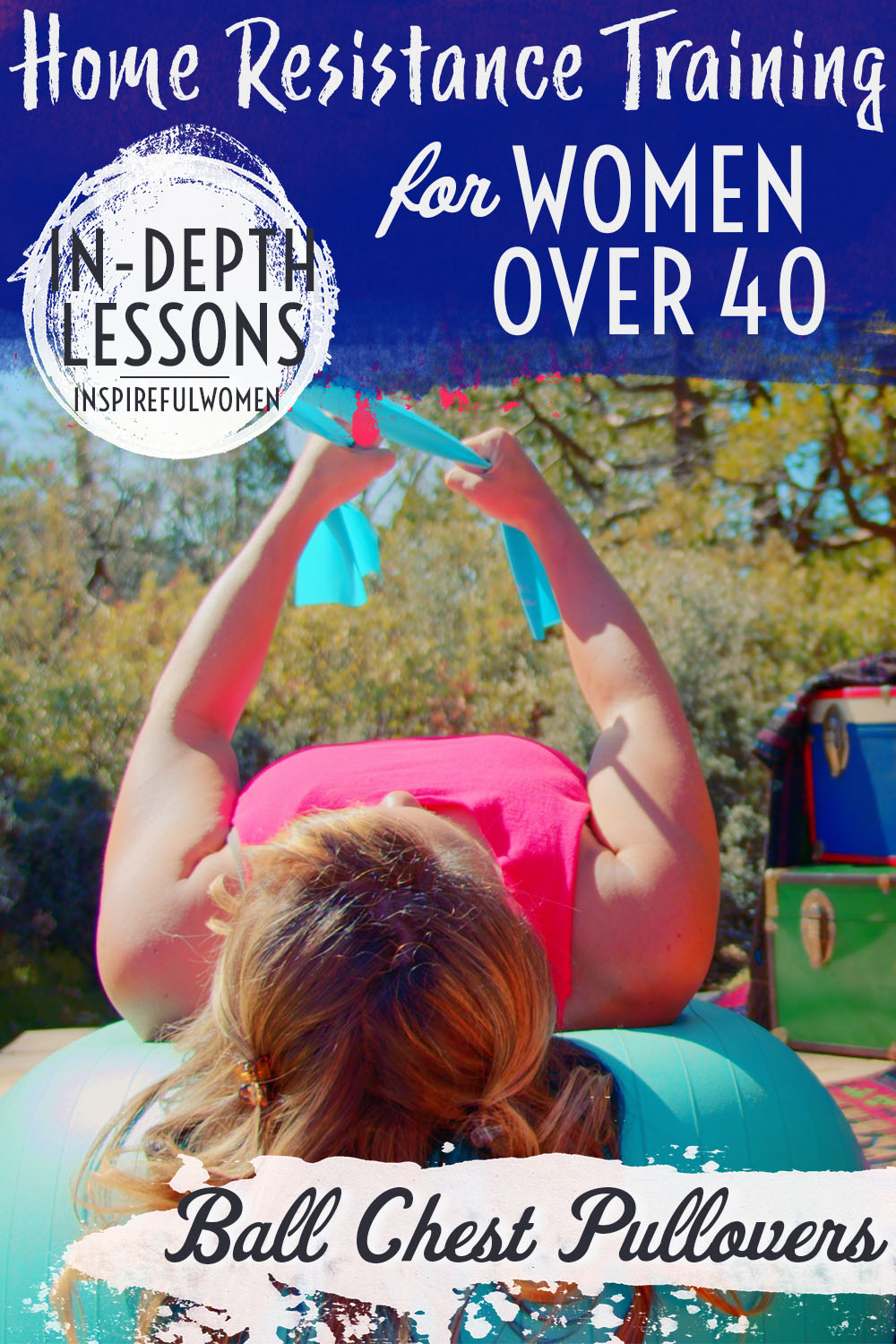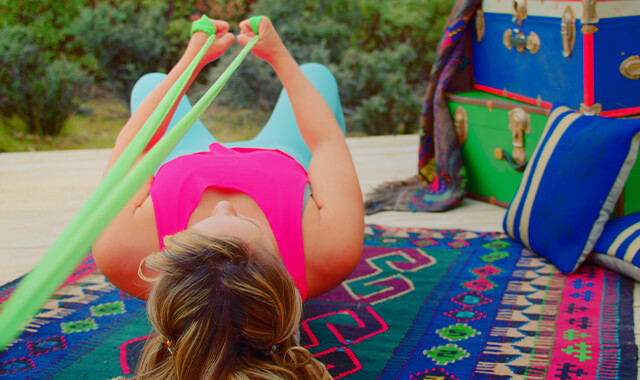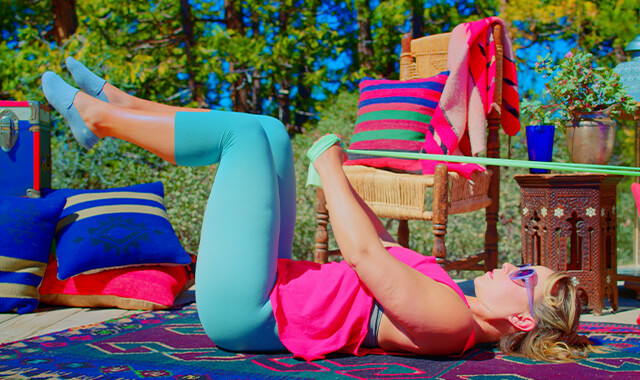band Chest Pullovers - exercise ball
How to Do Band Chest Pullovers on an Exercise Ball | In-Depth Guide [VISUAL LEARNERS] Beginner
Proper Form, Common Mistakes, & Variations | Home Resistance Training
WHAT DO YOU WANT TO SEE?
QUICK DEMO
QUICK DEMO
MUSCLES THIS WORKS
MUSCLES
MAIN MUSCLES WORKED IN the band Chest Pullover on ball
Pectoralis Major, Latissimus Dorsi, & Triceps
OTHER MUSCLES WORKED:
- Scapular movers and stabilizers (rhomboids, trapezius, levator scapula, serratus anterior)
- Rotator cuff
- Teres major
- Pectoralis minor
- Abdominals (rectus abdominis, transverse abdominis).
WHAT WE'RE DOING TODAY
WHAT & WHY
BENEFITS OF TRAINING THE Upper Body muscles
WHAT
WHAT WE'RE DOING TODAY
ALL WE'RE DOING:
With the band behind us, laying face up on the ball, we'll be pulling the band down to our hips.
Here's a great chest pullover at-home variation - no gym and no bench required! This chest pullover is done lying down on a stability ball. This is an effective way to sculpt and strengthen your upper body muscles.
IT’S A CHEST EXERCISE. NO, IT’S A LAT EXERCISE. NO, IT’S AN UPPER BODY COMPOUND EXERCISE.
That was such a corny reference to Superman! I just couldn’t help myself. I have a huge corny streak in my gene pool that has definitely expressed itself in my personality.
Pullovers work many of the muscles of the upper back, chest, and shoulders, and because of this, it’s considered a compound exercise- which simply means it trains a number of different muscles that surround more than 1 joint. Here we move a lot both at the elbow & shoulder joints.
This is an interesting exercise because there is quite a bit of controversy over which muscles the movement targets the most - the pectoralis major (main chest muscle), or the latissimus dorsi (our main back muscle)
Pullovers work both the front and the back of the torso, but your focus and control have a lot to do with which muscles are worked more. As the arms are pulled down, just concentrating on the muscles that you want to target will activate those muscles - so it is possible to really focus on pulling the arms over using the chest muscles OR to pull the arms over using the latissimus dorsi. Squeezing the hands in will also help to activate the chest muscles and moving the arms out to the side just a little bit will help to use the lats.
LARGE ROM MEANS IT’S GREAT FOR WARM-UP, ACTUAL STRENGTH BUILDING & COOLDOWN.
This exercise is done lying down on your back with your arms stretched overhead. This stretches the latissimus dorsi right before they are activated to pull the arms down to the sides of the body, while the core muscles work to hold the torso still. Pullovers move the shoulder joint through a large range of motion, working the smaller muscles of the shoulder blade and shoulder joint. This is a good exercise for all 3 types of movements we do when we workout:
- A great way to warm up the shoulder blades, and shoulder joint before exercising (done with a light resistance band)
- This exercise also works well for actual strengthening (using a strong resistance band)
- and as a cool down (once again using a light resistance band).
If you feel your low back arch as the arms are stretched over the head, it could be due to tightness in the lats. In this case, move the arms up just to the point where your spine is still in neutral & feel the arms kind of getting “stuck”, take a breath and relax to enjoy the bonus lat stretch in between reps. Do not push through discomfort or pain to get a bigger range of motion. You will still be able to train the muscles well while moving the arms through a range that feels okay to you. You may find that your range gradually increases as you do the movement.
ANOTHER LAYING DOWN EXERCISE YAY
This exercise is done lying down on your back - this is a good way to work on opening your chest up and getting the shoulders back to reverse the rounded back and shoulder posture that so many of us tend to sit in for too much of our day. This is a good exercise to do as a mid-day break to help relieve upper back discomfort and muscle tension and improve posture.
WHY BOTHER DOING IT?
WHY
WHY DO WE EVEN CARE?
LARGE RANGE OF MOTION = GREAT FOR YOUR BODY
The primary focus of this exercise is to work the largest muscles of the chest - the pectoralis major, and the back - the latissimus dorsi, as the arms are pulled down. But. Another benefit of this movement is that the shoulder blades and upper arm bone (humerus) move through a very large range of motion. When the arms move through this large range of motion, the shoulder blades rotate up and down, the collar bone moves at its connections to the shoulder blade and the sternum, and even the ribs move - up and down and rotate.
Moving all of these joints through this large range does the following 4 things:
- moves the soft tissues - like muscles, fascia, and ligaments
- lubricates the joints
- brings blood to the tissues, and
- gets rid of waste in order to keep the shoulder moving well.
Large movements are so important for keeping the joints and muscles healthy. Think about your day - how many times a day do you do things that take your arms up overhead? Most of our daily activities are done in a very limited range of movement, with most of the time spent with the arms lower than parallel to the floor.
KEEP THE HAIR STYLIST INSIDE YOU ALIVE & KICKING FOR YEARS TO COME.
Aka improve and/or maintain your ability to move your arms overhead.
While many of our daily activities involve using our arms more in the lower range of shoulder height or below, things like doing your hair every day is a major “arms overhead” activity. Oh there’s other things too, but that’s a pretty daily occurrence that’s like….mandatory for most of us ladies.
Exercises that involve taking the arms overhead can cause joint irritation in some people. Pullovers can be really good for stretching muscles and getting joints moving but it is important to be careful and never push through pain or discomfort. It is fine to do this exercise in a smaller range of motion. That said, this movement can be used to improve your ability to use your arms overhead in daily function and exercise, which means- Ta-da, you’ll always be able to blow-dry your hair all by yourself. ;-
KEEP OUR TORSO STRENGTH BALANCED WITH OUR ARM STRENGTH
The muscles on the front and back of the torso need to be able to work as you lift, push, and pull with the arms. The stronger the arms are, the stronger the muscles of the torso need to be. We can’t just do bicep curls & tricep extensions for a year and skip out on our lats & upper back & chest or we’re gonna have problems.
The pullover is a good way to work on improving the strength of some of the largest muscles of the torso.
EVERYDAY LIFE
EVERYDAY LIFE &
MUSCLE FUNCTION
HOW WE USE OUR Upper Body MUSCLES IN EVERYDAY LIFE
1. LATISSIMUS DORSI
- Pulling the arm down (extension), in towards the midline of the body (if you drew a line down the middle of your body to divide it into left and right halves - the line would be the “midline”), rotates the upper arm in (internal rotation)
- Swimming - crawl - the arm moves down, in towards the sides, and rotates in
- Cross country skiing
- Pulling a curtain cord down
- Moves and stabilizes the shoulder blade - during all arm movements
- Depresses (pulls down) the shoulder blade
- Holds the shoulder blade down to provide a stable base for your arm to work off of
- Holds the torso in a healthy upright posture
- Stabilizes and protects the low back during arm use -especially lifting, pushing, and pulling
2. PECTORALIS MAJOR
- Bringing the arm across the body, towards the midline (Horizontal adduction)
- Reaching across to fasten a seat belt
- Pulling a car door shut
- Putting a belt into pants (reaching across to the opposite side in front of the body)
- Lifting objects in front of the body
- Carrying heavy things in front of you
- Bring the arm down and across
- Reaching the opposite hip
- Rotating the upper arm in (internal rotation) of the arm
- Rotating arm down to empty a can
- Can help to the shoulder blade down the back, rotate the shoulder blade down, move the shoulder blade around the ribcage (protraction), and to stabilize the shoulder blade and the shoulder joint
- Control during all arm and hand activities that require strength and/or precision - writing, knitting, using a screwdriver
3. TRICEPS
- Straighten the elbow (all three heads)
- Washing windows - straightening the elbow
- The long head acts to pull the arm down from a flexed (the arm is reaching overhead or out in front of the body), and moves it behind the body. (this action is not used in the floor press exercise)
- Pulling a cord down to open the curtains
- Pulling yourself up when climbing a ladder
- All three heads help to stabilize the elbow joint
- Control during all hand activities that require strength and/or precision - writing, knitting, using a screwdriver
- The long head helps to stabilize the shoulder joint
- Control during all hand activities that require strength and/or precision - writing, knitting, using a screwdriver
The pectoralis, lats, and triceps work together for shoulder adduction, internal rotation, and elbow extension in activities like pushing a stroller or lawnmower, using crutches, pushing yourself up out of a pool - hands on the side of the pool, pushing up from the floor, climbing a ladder if you are pulling up with the arms.
The lats and pecs work to stabilize the shoulder blade and shoulder to provide a solid base for the arms to work off of during heavy lifting, pulling, and pushing.
STARTING POINTERS
Starting Pointers
Notes on this one- it’s honestly a PAIN to find the right position to start with, BUT once you do, I love the additional muscle activity going on with the rest of the body- especially my hamstrings! You’ll see.
Stability Ball Pullovers transform an upper body exercise into a full body exercise - adding the muscles of the feet, legs, hips and pelvis. The latissimus dorsi work with the gluteus maximus (they are connected through the thoracolumbar fascia) to stabilize the low back, pelvis, and hips. The muscles of the abdomen and low back will have to work harder to hold the position and stabilize the torso.
Using a band will let you work the latissimus dorsi more if you pull the hands down towards the hips, that is a choice. The further the band is pulled the more the lats will be working.
HOW TO DO THE EXERCISE
LOOKS
HOW Stability Ball Chest Pullovers SHAPE OUR BODY
Toned chest, arms, V shaped back.
PROPER FORM
PROPER FORM: band Chest Pullover on ball
EQUIPMENT, SETS & REPS
EQUIPMENT
Main set (3: Light/Med/Heavy)
X-Heavy Band (I recommend getting this too if you plan to use resistance bands frequently).
Stability Ball
SUGGESTED STARTING WEIGHT FOR WOMEN:
Light to moderate resistance bands
SETS & REPS:
2 sets of 8 reps
PACE:
Slow lowering overhead, quicker up
BODY POSITION
BODY POSITION FOR THE band Chest Pullover on ball
BAND: Anchor the band about 4-6 inches higher than the top of the ball - before you sit on the ball. Sit on the ball, holding the ends of the band, facing away from the band anchor - the band is behind you. Walk your legs out until your upper back and head are supported and resting on the ball. You may need to play around with positioning - the goal is to start with your arms up overhead and pull them down until your hands are above your pelvis. And you want the band higher than your hands when your hands in the starting position overhead.
BODY STANCE: Push your pelvis and hips up - you should be able to draw a straight line down from your earlobe - shoulder- hips - knees. Your shoulders should be pressed back in contact with the ball- your chest open. Neutral spine, includes your neck.
LEGS/FEETt: Knees bent. Feet flat on the floor.
ARMS: Your arms are held overhead not quite parallel to the floor. To check the range of motion of your shoulder joints, take your arms up overhead. If you have tight lats or restrictions in the shoulder joint range of motion stop before you feel discomfort, or when you feel resistance. Avoid pushing your arms further overhead.
HAND/GRIP: Neutral grip (palms facing in), holding one end of the band in each hand. Hands close together.
HOW TO DO
HOW TO DO Stability Ball Chest Pullovers
CUE: Focus on using your chest muscles to control the movement of your arms.
With your hands pressed together, arms straight, pull your arms down past your head & continue pulling until your hands are above your lower abdomen. If you find it difficult to find a band or setup where there is much tension on the band during the first half of the range of motion in order to pull all the way to your lower abs/hips, you can shorten the ROM so that you only pull to midchest, which will allow you to use a stronger band for better chest muscle activation in that range (from overhead to midchest range).
Slowly return your arms overhead for the next rep.
Repeat for the desired number of repetitions.
HOW TO SAFELY GET OUT OF THE EXERCISE
With your hands overhead, release the band. Bring your hands to your thighs. Lift your chin towards your chest and continue to curl the spine up into sitting using your abdominal muscles as you walk your feet back to the starting position.
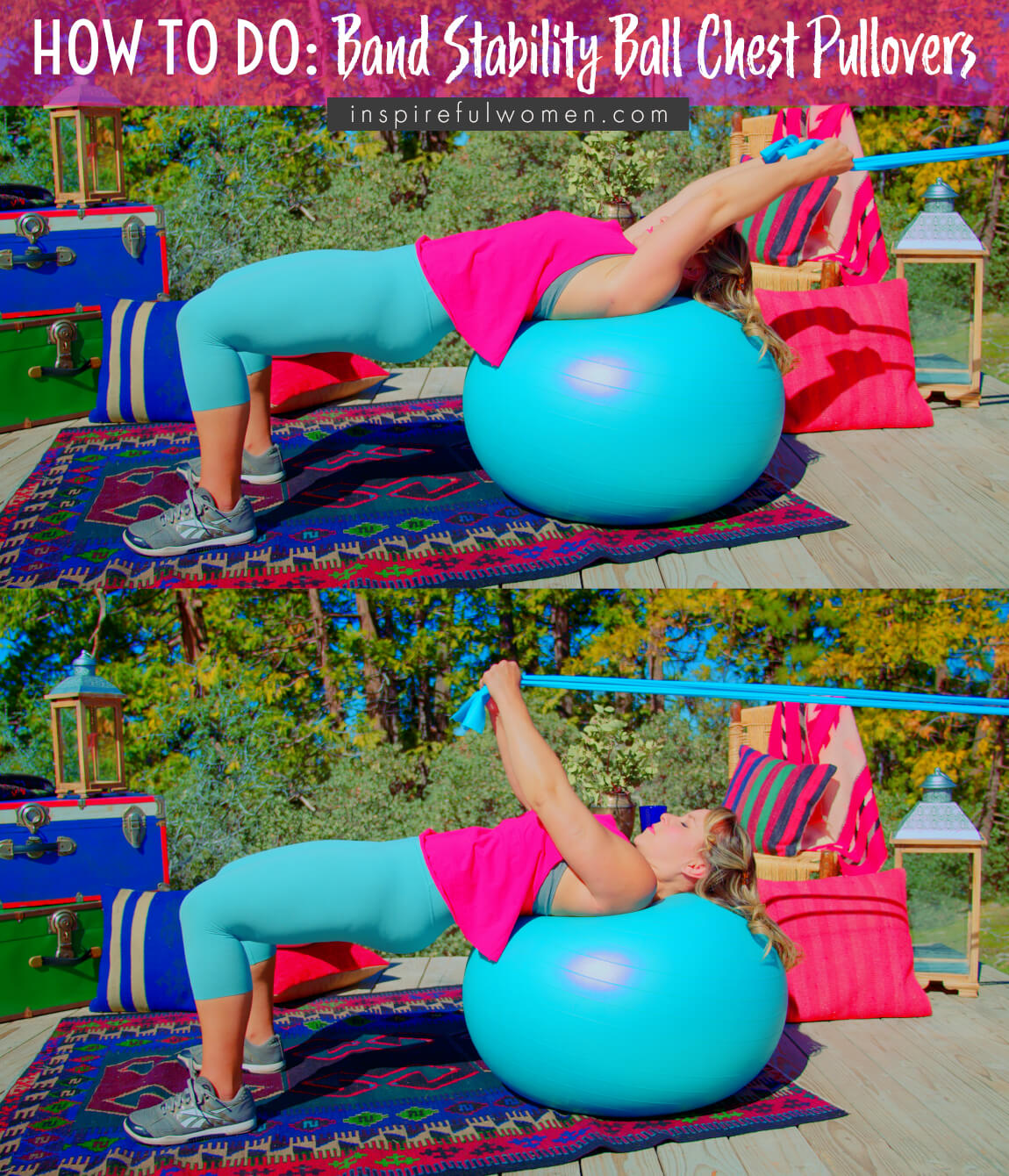

COMMON MISTAKES
COMMON MISTAKES
WHAT TO AVOID WITH THE Stability Ball Chest Pullover
KEY TIP:
Guess what? Good news! Many avoids are the same for most movements. Once you learn the basics, there's really only a few extra avoids for each individual movement.
1. Avoid dropping hips
AVOID: Letting the hips drop
WHY NOT?
- This will decrease the activity of the lats, gluteus maximus and hamstrings.
WHAT TO DO:
- You should be able to draw a line through the earlobe, shoulder, hip, and knee.
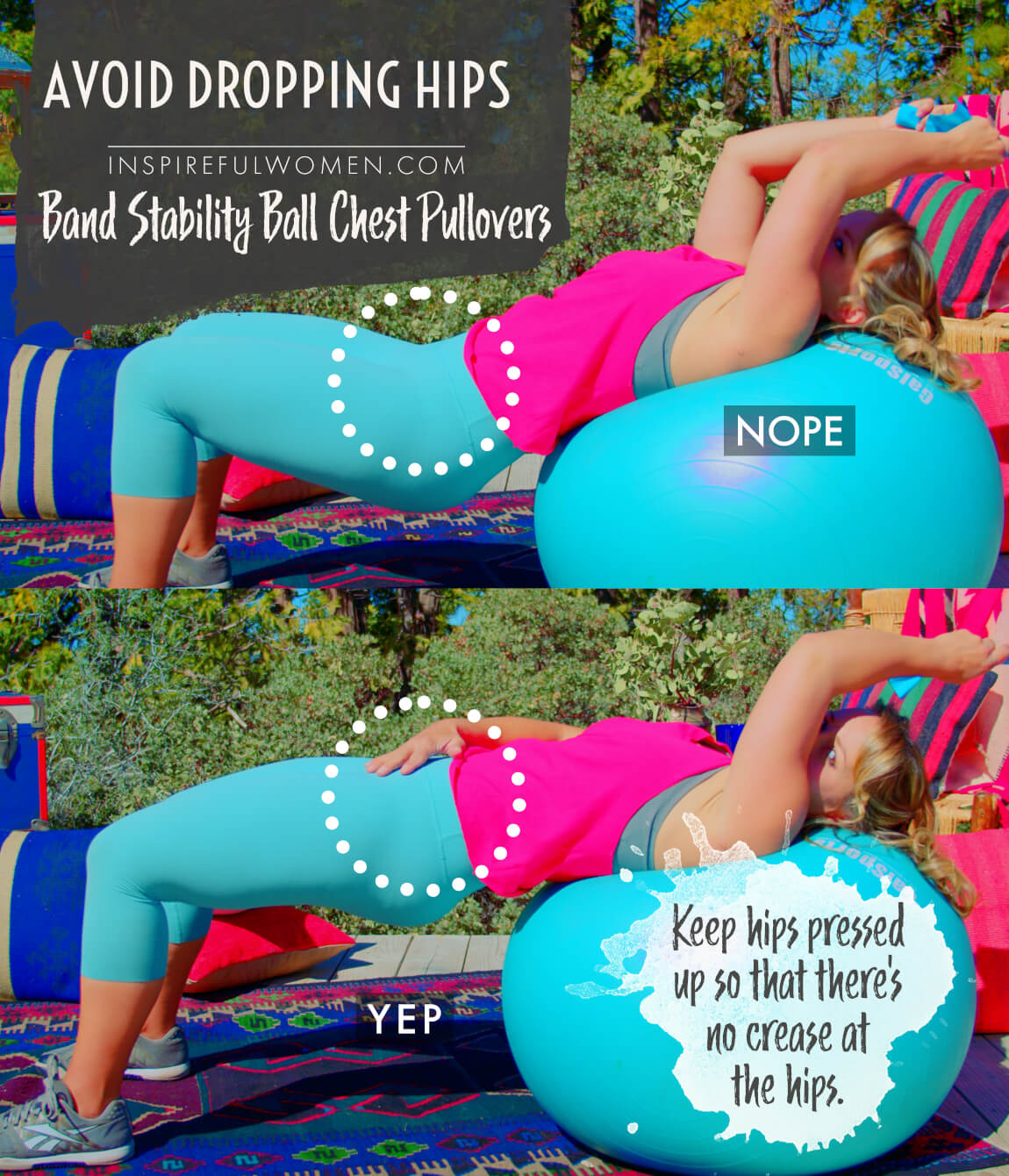
2. Avoid Flattening your Low back
AVOID: Flattening your low back.
WHY NOT?
- Will change the muscle activity of the core muscles.
WHAT TO DO:
- Maintain a neutral spine position to prevent injury or muscle strain.
- You should not be able to feel your low back pressed on to the floor, you should be able to slip your hand between the floor and your low back.
- Try
- Lowering your tailbone to the floor and lengthening the front of your torso, activate the core muscles gently to hold this position.
- Pressing the back of your shoulders into the floor.
- Relaxing the muscles of the lower body (especially glutes), concentrate on the core and upper body.
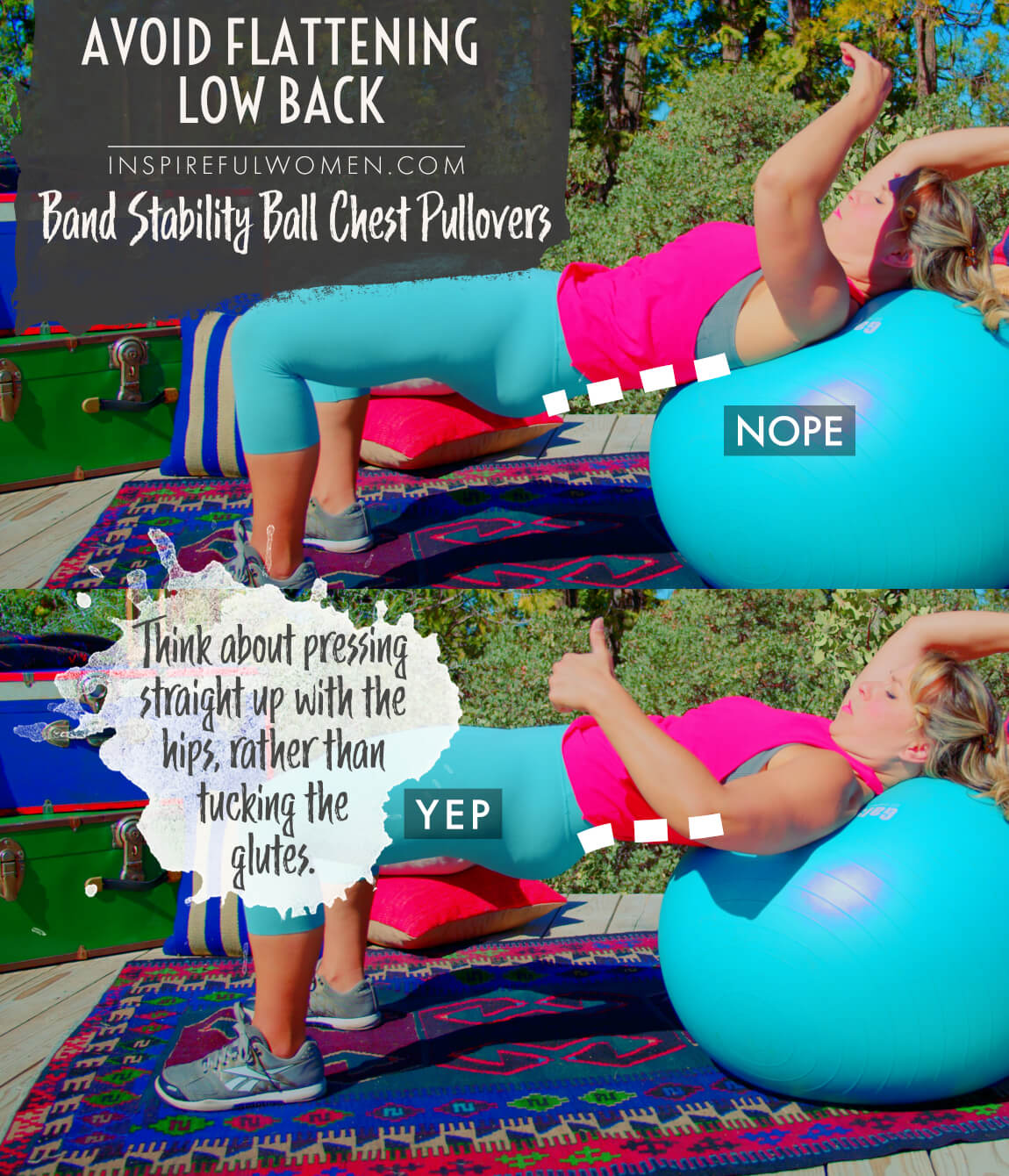
3. Avoid Arching Low Back
AVOID: Arching your low back.
WHY NOT?
- This will decrease the muscle activity of the low back and abdominals.
WHAT TO DO:
- Maintain a neutral spine position to prevent low back joint injury, muscle strain or damage over time.
- If your ribs lower ribs flare upwards or your belly is lifted up - this indicates you are arching your low back. Your pubic bone and front hip bones should be in one plane - can check by placing your fingertips on the pubic bone and setting the base of your palm on the hip bones - your hand should be flat.
- This can happen when you take the arms up too far overhead, especially if you have a tight upper back, lats, or shoulders.
- Try limiting how far you take the arms overhead.
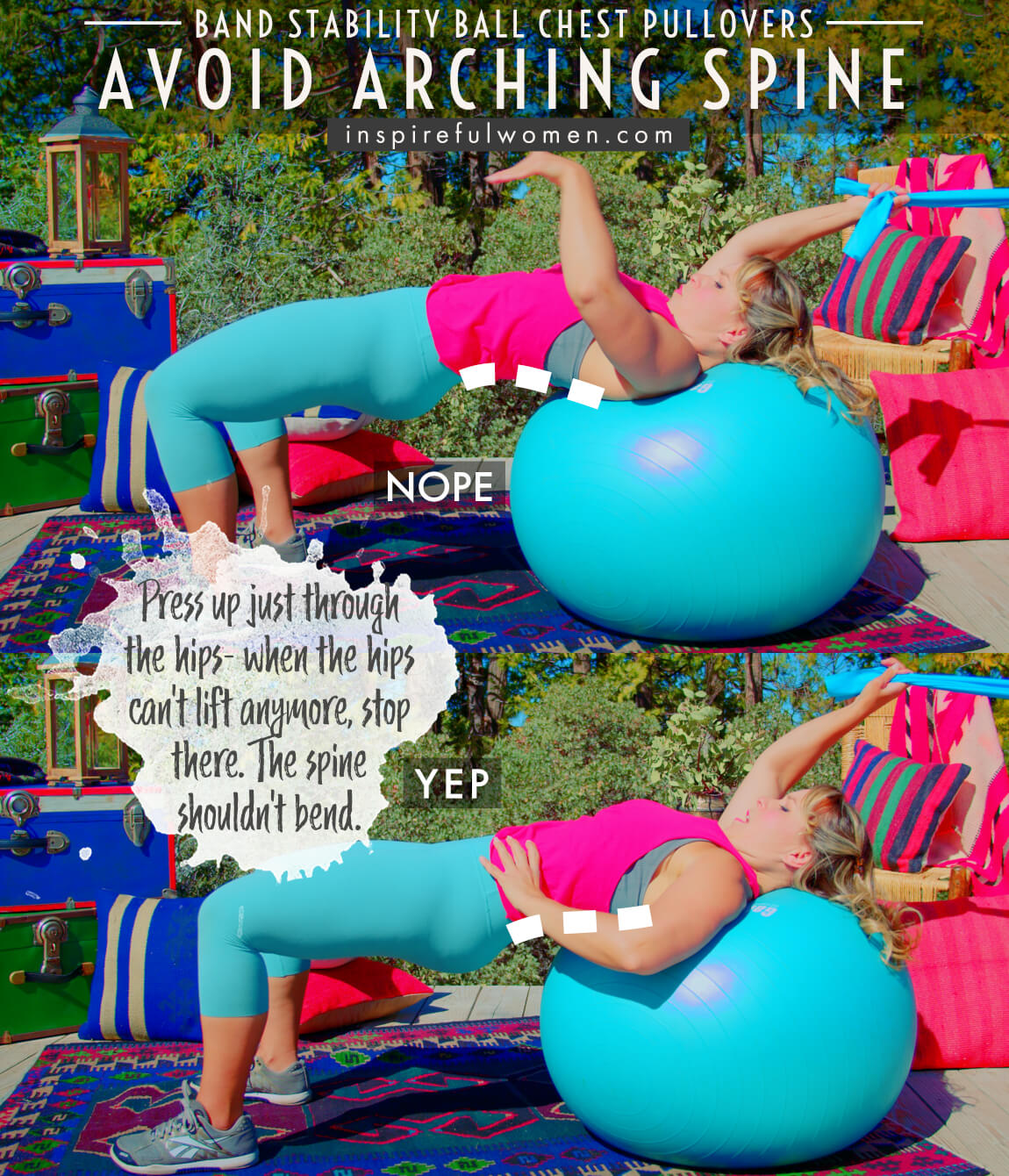
4. Avoid Bending Wrists
AVOID: Bending at your wrists.
WHY NOT?
- Poor alignment (bent forward or backward) or repetitive movement through the wrist can lead to joint and/or soft tissue irritation or injury over time.
WHAT TO DO:
- Your wrists should be in line with your forearm and should be still throughout the exercise.
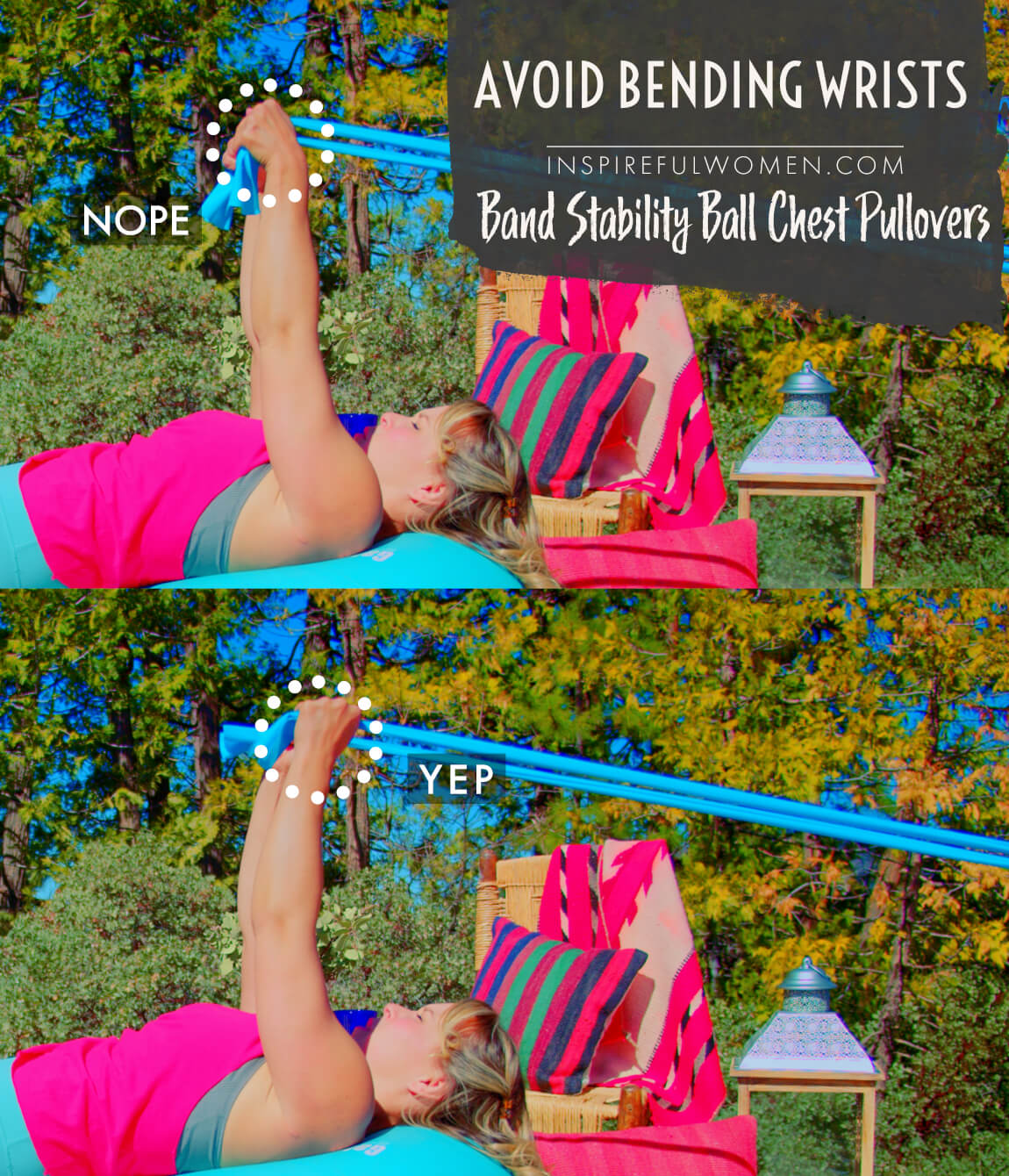
5. Avoid Hands Too Far Apart
AVOID: Hands too far apart.
WHY NOT?
- This can irritate the tissues.
- Reduces the effectiveness of the exercise.
WHAT TO DO:
- Keep the hands close together.
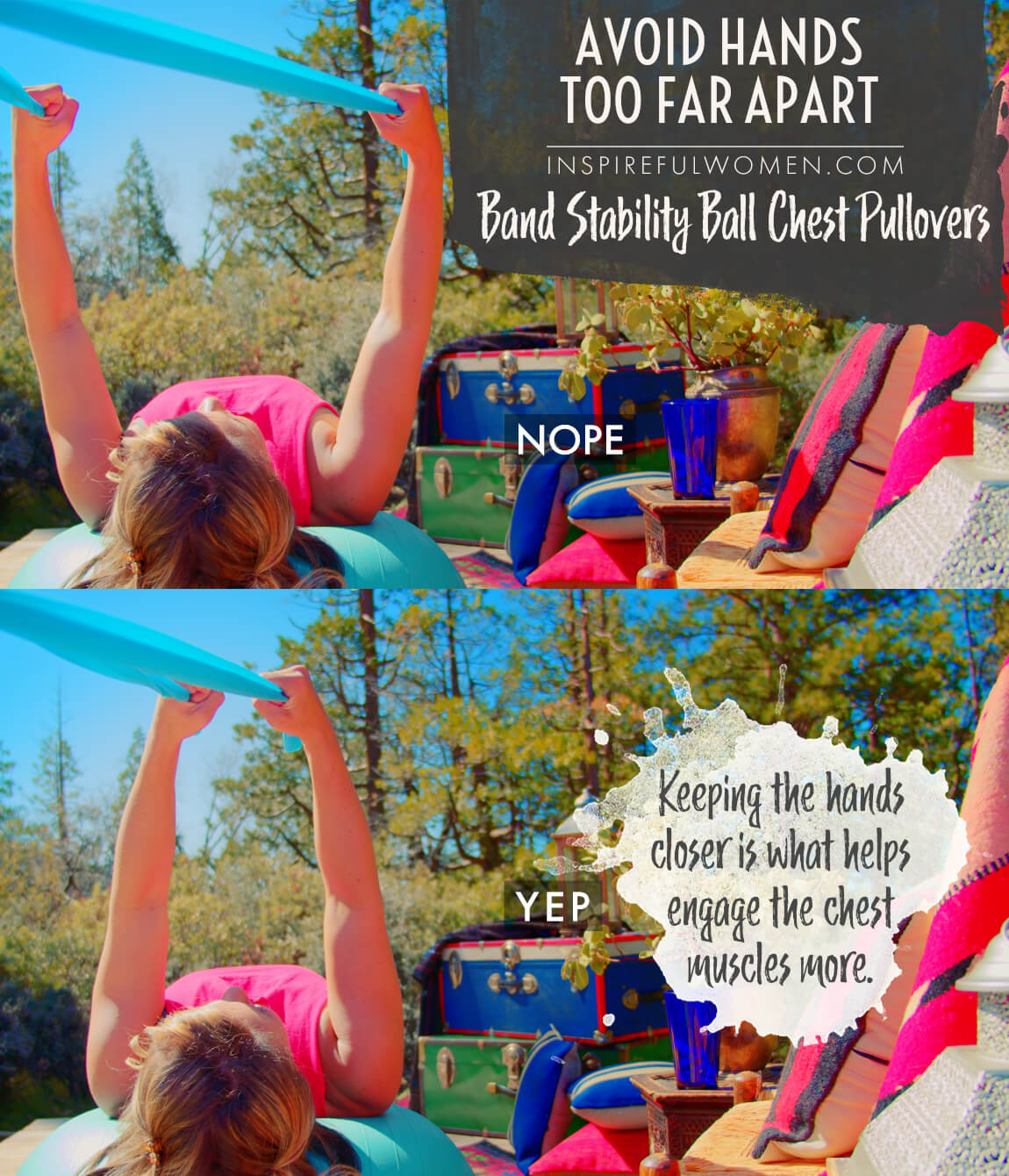
6. Avoid Rounding Shoulders
AVOID: Lifting your shoulders off of the floor
WHY NOT?
- Rounding the shoulders (shoulder blade protraction, upper arm internal rotation, humerus- upper arm bone, glides forward) closes down on the space in the shoulder joints and can result in irritation of the tendons.
WHAT TO DO:
- You should be able to feel the back of the shoulders should be firmly planted on the floor.
- Sometimes the shoulders will not rest on the floor because the chest muscles are too tight. Use the position to work on stretching the pecs by pushing the shoulders back into the floor and relaxing.
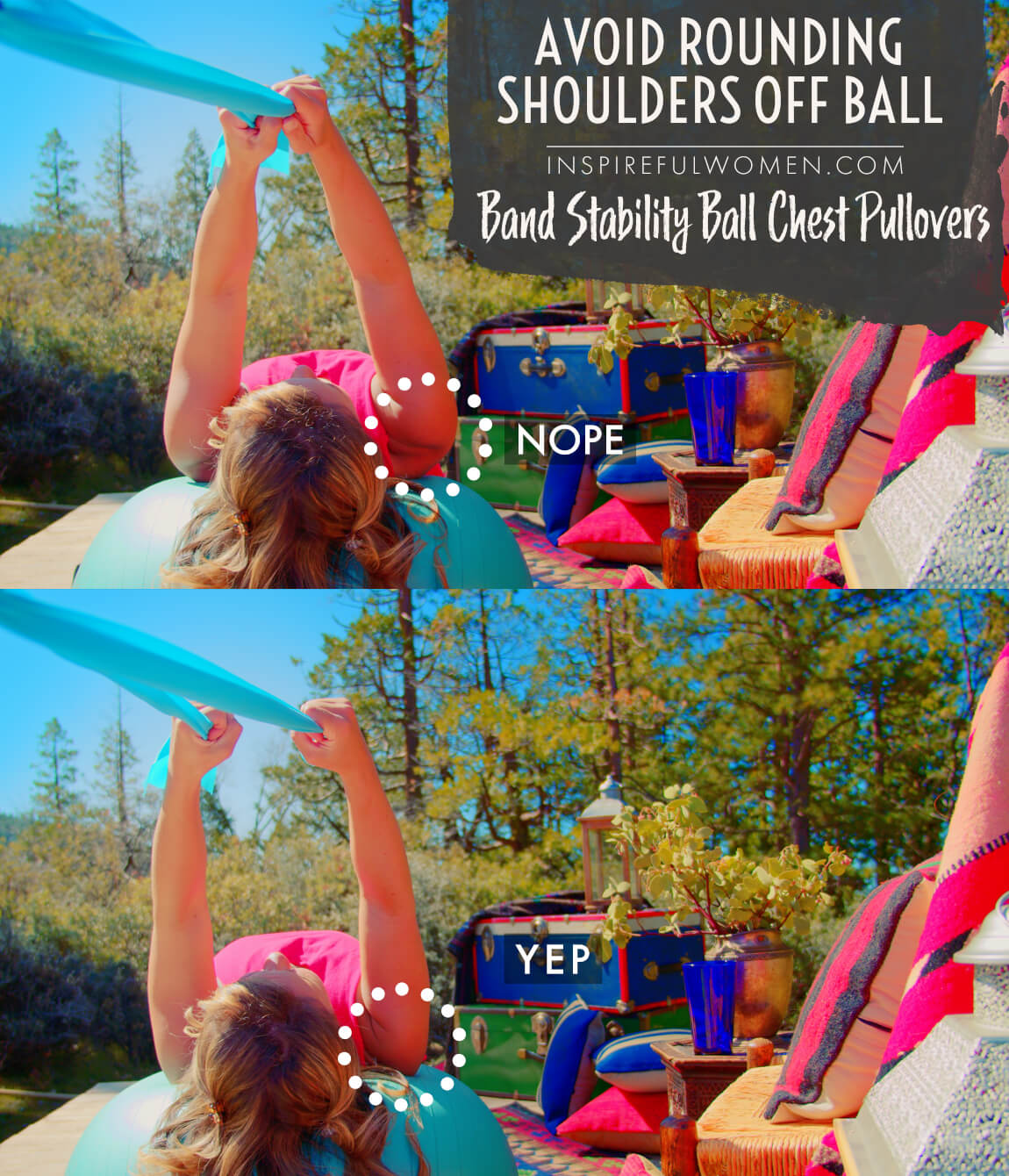
VARIATIONS
VARIATIONS
VARIATIONS OF Stability Ball Chest Pullovers
Knees More Bent
Knees More Bent Glute Focus Pullovers
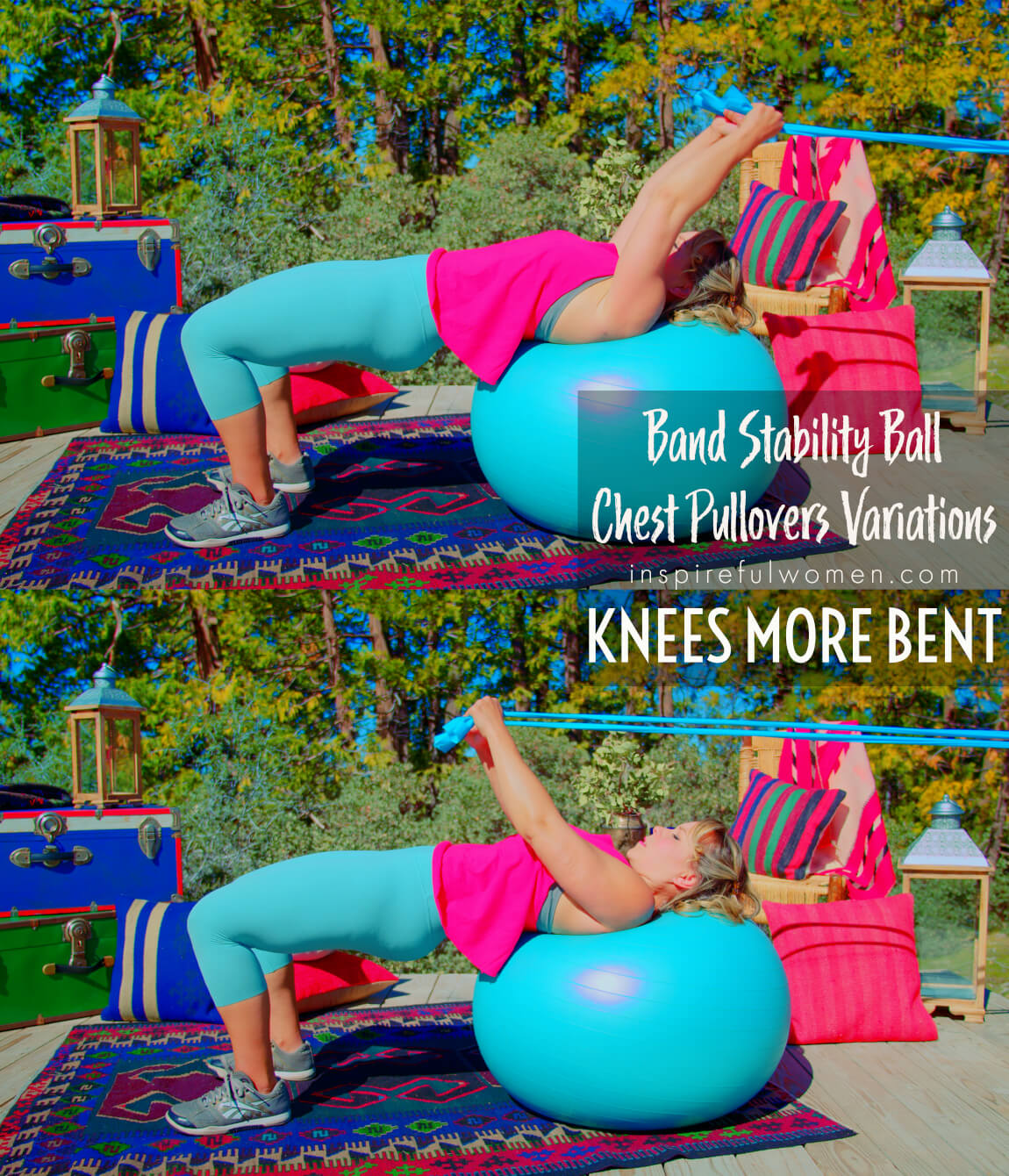
Feet Further Out
Feet Further Out Hamstring Focus
When your legs are a bit straighter- less bend to the knee, this will work the hamstrings more.
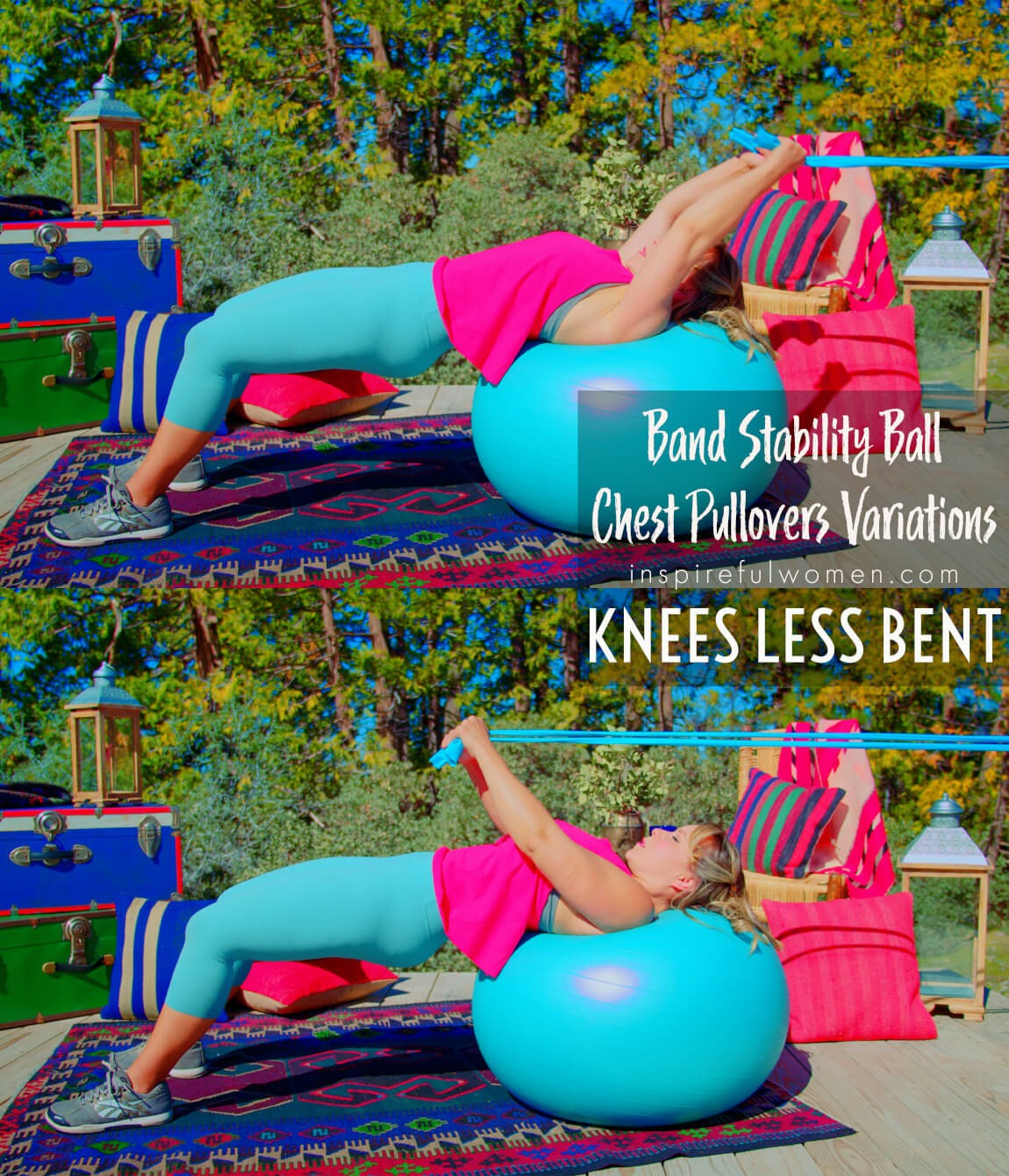
Hands Further Apart
hands further apart at end
If you would like to activate the lats more, continue the movement to stretch the band further and lower the arms down towards the torso - as the arms pull down you can separate the hands - moving them to the sides of the torso.

Feet Spacing
Feet Position Chest Pullover
Feet closer together is less stable and will work the leg and core muscles more. Feet wider apart will be more stable and will be less challenging.
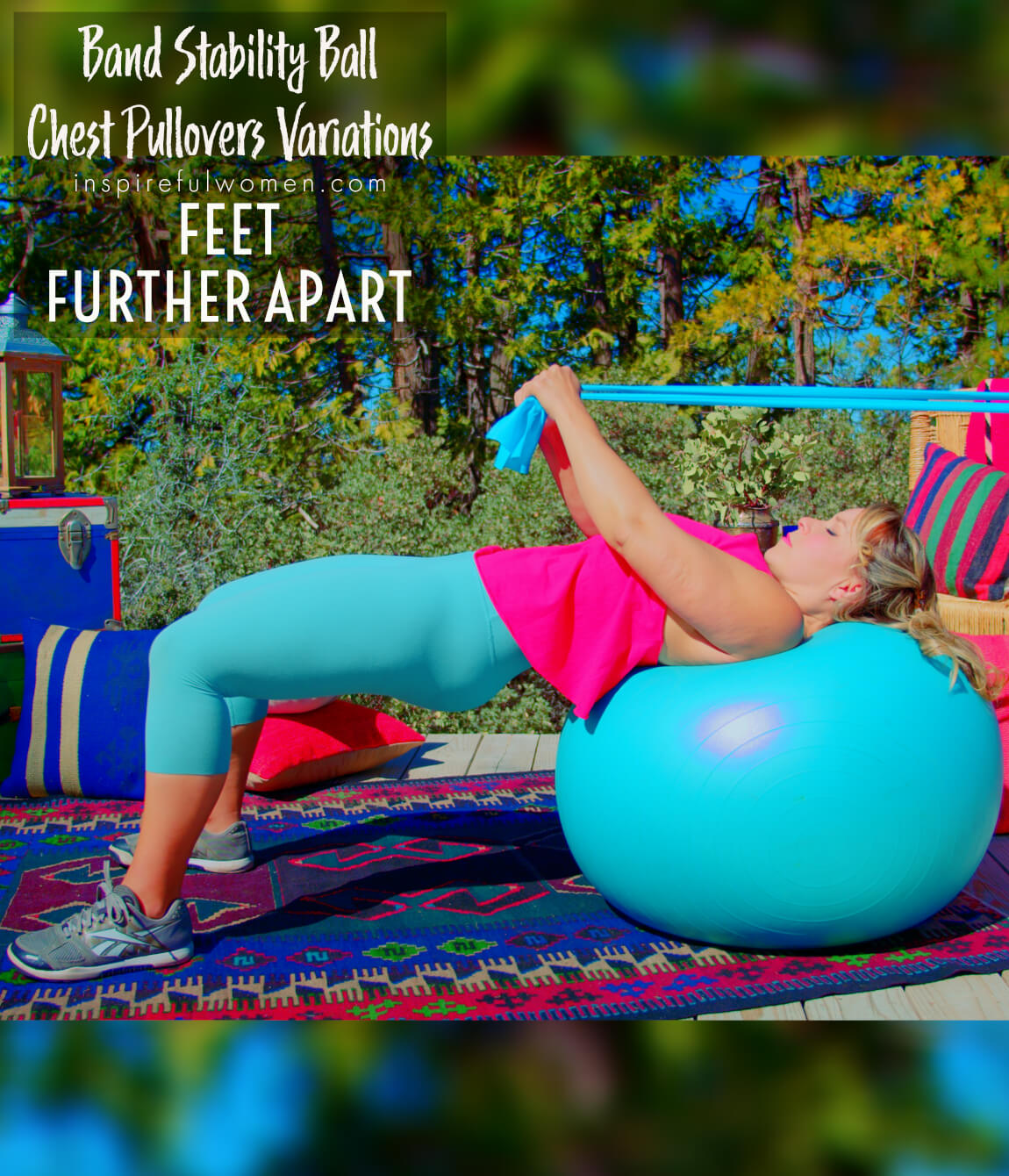

SCIENCY STUFF
SCIENCY STUFF
SPIFFILICIOUS FACTS ABOUT MUSCLES & MOVES
Letting a heavyweight pull the arms too far back will strain or injure the shoulder joint. It is important to remember that the shoulder joint is very unstable, it should not be overloaded at the end of its range of flexion - nearly straight in line with the torso. This becomes even more important when someone has a limited shoulder range of motion, pushing it through the restriction with a heavy load can cause serious injury to the ligaments, cartilage, muscles, or even bone.
ALLLL MUSCLES & WHEN
ALL MUSCLES WORKING & WHEN DURING THE Stability Ball Chest Pullover
The muscles of the feet and legs, along with the core muscles will work to hold the body still throughout the exercise.
The pectoralis major will work isometrically to hold the arms together in adduction at midchest throughout the entire movement. The triceps are working to hold the arm straight, and the forearm, upper arm, and rotator cuff muscles are working to hold the wrist, elbow, and shoulder still. The latissimus dorsi, teres major, and the long head of the triceps initiate the movement with an eccentric contraction as the hands are lowered down over the head. As the arms go overhead the serratus anterior and trapezius rotate the shoulder blade upward.
The latissimus dorsi, teres major, and pectoralis major (lower fibers) work concentrically to pull the arm back up to 90 degrees of flexion.
The back extensors work to maintain a neutral spine (prevent the spine from flexing as the arms are pulled back up. The pec minor and major, rhomboids, levator scapulae, and latissimus will return the scapula from upward rotation to neutral rotation (this is minimal - it is mostly due to the serratus anterior and trap relaxing and the shoulder blades repositioning passively as the arms are pulled back up.
When the arms reach the chest (perpendicular to the floor), the lats, teres major, triceps, and lower fibers of the pectoralis major work concentrically to pull the arms down towards the torso.
To return to the starting position (arms overhead) the lats, teres major, triceps, and lower fibers of the pectoralis major work eccentrically to control the motion, as the arms get closer to perpendicular to the floor, the pectoralis will contribute more.
PIN IT FOR LATER!
